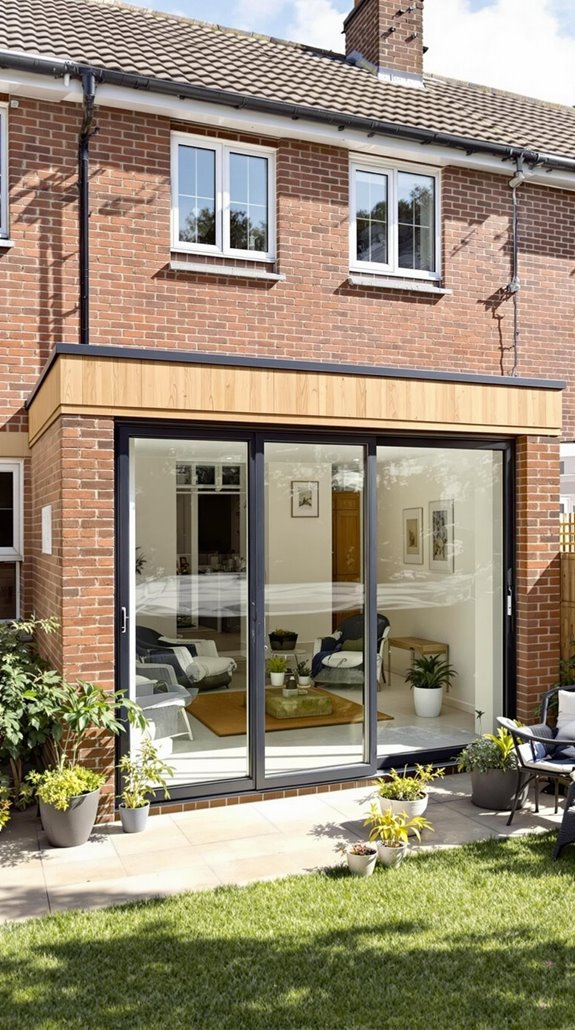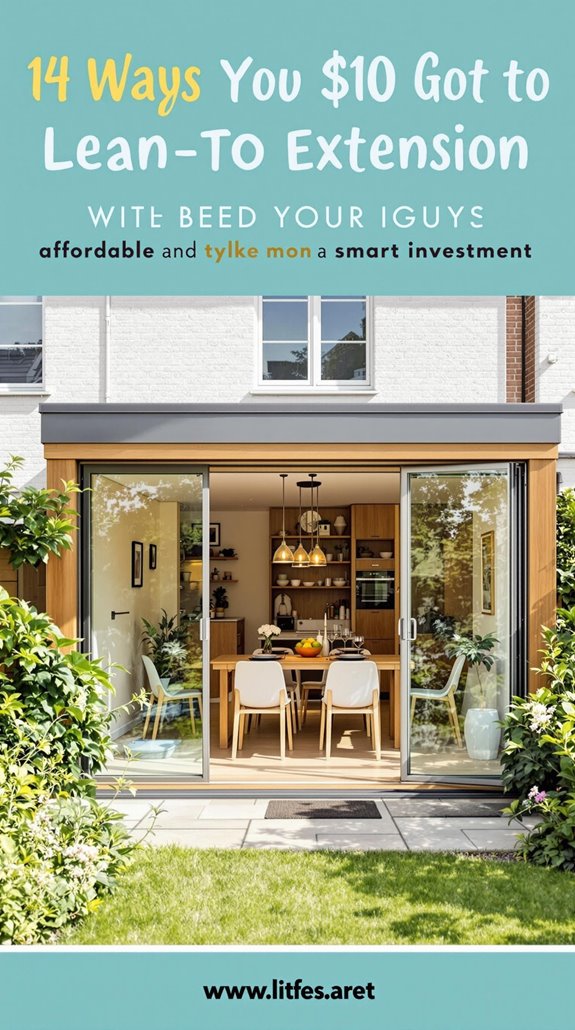I’ve helped dozens of homeowners transform their properties with lean-to extensions, and I can tell you that understanding the real costs upfront makes all the difference. You’re looking at £1,800 to £3,500 per square metre, but that’s just the starting point. The materials you choose, your site conditions, and specific design decisions will dramatically impact your final bill. What most people don’t realize is how three simple strategies can cut your costs by nearly 40%.
Key Takeaways
- Lean-to extensions start from £1,800 per square metre for basic uPVC structures, offering affordable space expansion.
- Keep designs simple and use existing doorways to avoid additional structural costs and reduce overall expenses.
- Choose timber frame construction over other materials as it’s faster to build and reduces labour costs significantly.
- Salvage existing materials from your property to lower expenses while supporting sustainable building practices.
- Build during dry weather conditions to avoid complications, delays, and additional costs from weather-related disruptions.
Understanding Lean-To Extension Costs and Budget Planning

When planning a lean-to extension, you’ll face costs ranging from £1,800 to £3,300 per square metre, with material choice serving as the primary cost driver. I’ll break down what you’re looking at: basic uPVC structures start at £1,800/m², while premium oak frames reach £3,500/m². Don’t forget VAT adds 20% to your total. Additionally, typical renovation projects can vary widely in cost, so it’s crucial to conduct thorough research.
Your budget planning toolkit should include a 10-15% contingency for structural surprises. Labour typically eats up 40-60% of costs, so getting multiple quotes is essential. Location matters too—London builders charge 25-30% more than regional counterparts. Professional fees from architects and engineers will add another 10% to your total project cost.
Smart strategies include phasing luxury finishes for later completion and prioritising energy-efficient features. Remember, lean-tos cost 18-45% less than side returns, making them the practical choice for budget-conscious homeowners.
Timeline and Labour Requirements for Your Project
Before you break ground on your lean-to extension, you’ll need to navigate a structured timeline that spans 6-10 months from initial design to final completion. I’ll break down the critical phases so you can plan effectively.
Your design phase consumes 2-3 months, followed by planning permission adding another 3+ months. During this time, it’s essential to ensure that your design meets planning permissions to avoid any delays. Construction takes 10-16 weeks for standard builds, though complex designs extend to 24 weeks. You’ll need a crew of 3-5 tradespeople managed by your main contractor, with specialists rotating through specific phases.
Critical milestones include groundworks (1-2 weeks), structural build (2-3 weeks), and achieving watertight status by week 6. Factor in potential delays: planning revisions, structural surprises, or weather disruptions can add weeks to your schedule. Prepare a contingency budget of 10-15% of your total budget to handle unexpected issues that inevitably arise during construction.
Smart Money-Saving Strategies for Extension Construction

Since extension costs can quickly spiral beyond your initial budget, implementing strategic cost-saving measures during construction becomes essential for project success. I’ll focus on practical strategies that maximize your investment while maintaining quality.
First, I recommend optimizing your design for cost efficiency by keeping layouts simple and avoiding complex structural features like cantilevered elements or curved walls. You’ll save notably by using existing doorways rather than creating new openings that require steel beams. Additionally, understanding average price ranges for different types of renovations can help you make informed decisions about your project’s scope.
Choose timber frame construction over traditional methods—it’s faster to build, reducing labor costs. I suggest discussing alternative construction methods with your contractor early to identify potential savings.
Consider salvaging existing materials like floorboards and doors instead of buying new. This reduces both skip costs and material expenses while supporting sustainable building practices.
Building during dry weather conditions helps avoid frost and rain complications that can increase construction costs and cause delays.
Key Factors That Impact Your Extension Investment
While smart construction strategies help control costs, understanding the fundamental factors that drive your extension investment allows you to make informed decisions from the project’s outset. I’ll break down the key variables that’ll impact your budget.
Size directly affects your cost per square metre, with single-storey extensions averaging £1,800-£3,500 per m². Material choices matter greatly—standard specifications cost £1,900-£2,400 per m², while premium materials push costs beyond £2,700 per m². Additionally, it’s crucial to consider permitted development rights, which can allow certain extensions without needing formal planning permission.
Professional services typically consume 10% of your budget, plus regulatory fees: Building Regulations (£1,200), planning permission (£600), and potential party wall agreements (£1,500-£3,000 per neighbour). Additionally, skilled labour costs have risen significantly and now account for 30-40% of your total project budget.
Your existing property’s age and condition influence costs through necessary electrical, plumbing, or insulation upgrades. I recommend adjusting extension size to meet your budget rather than stretching finances.
Property Value Returns and Investment Benefits

Understanding your extension’s return on investment transforms this project from a simple home improvement into a strategic financial decision. I’ll break down the numbers that matter for your lean-to extension investment.
Lean-to extensions typically deliver 10-20% property value increases since they’re single-storey additions. You’re looking at solid returns compared to other extension types: loft conversions hit 20%, double-storey extensions reach 12%, and kitchen extensions add 10%. Since lean-tos often house kitchens or utility spaces, you’re positioned well within this range. Additionally, property value returns can vary significantly based on the quality of the build and design.
Location greatly impacts your returns. In high-demand areas like London, you’ll exceed national averages. Rural properties may see lower gains. For cost analysis, single-storey extensions averaging 20m² cost around £48,000 while potentially adding 10-20% value to your home.
Beyond monetary returns, extensions enhance your living experience by improving comfort, functionality, and overall enjoyment of your home space. This makes the investment worthwhile even when financial gains vary by location and property type.
Conclusion
I’ve outlined the core technical considerations for your lean-to extension project—from cost analysis at £1,800-£3,500 per square metre to labour scheduling and value engineering strategies. You’ll need proper planning tools, accurate measurements, and skilled contractors to execute successfully. Focus on timber frame construction and existing doorway integration to optimize your budget. With careful execution, you’re looking at 10-20% property value increases that’ll justify your investment long-term.
References
- https://www.myjobquote.co.uk/costs/house-extension
- https://www.homebuilding.co.uk/advice/how-much-does-an-extension-cost
- https://www.rightmove.co.uk/press-centre/how-much-will-it-cost-to-build-an-extension-use-our-new-calculator/
- https://www.checkatrade.com/blog/cost-guides/house-extension-cost/
- https://www.myjobquote.co.uk/costs/side-extension
- https://www.drawandplan.com/new-blog/2025/1/26/navigating-the-costs-of-home-extensions-in-2025-a-comprehensive-guide
- https://www.homebuilding.co.uk/advice/how-long-does-an-extension-take
- https://resi.co.uk/advice/construction-advice/construction-timelines-extension-conversion
- https://www.youtube.com/watch?v=y14HckblTwA
- https://www.self-build.co.uk/beginner-guide-to-home-extensions/

